
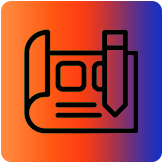
*******************************************************************************
Task: Applications and Implications
Propose a masterpiece of the final project that integrates the range of units covered.
********************************************************************************
Welcome to the applications and implications assignment, this week is dedicated to planning our final project. These days we must define the objectives, functionalities, materiality, costs and manufacturing processes of each of the pieces of the project.
(I01) Final project: Children's furniture inspired by the Montessori methodology
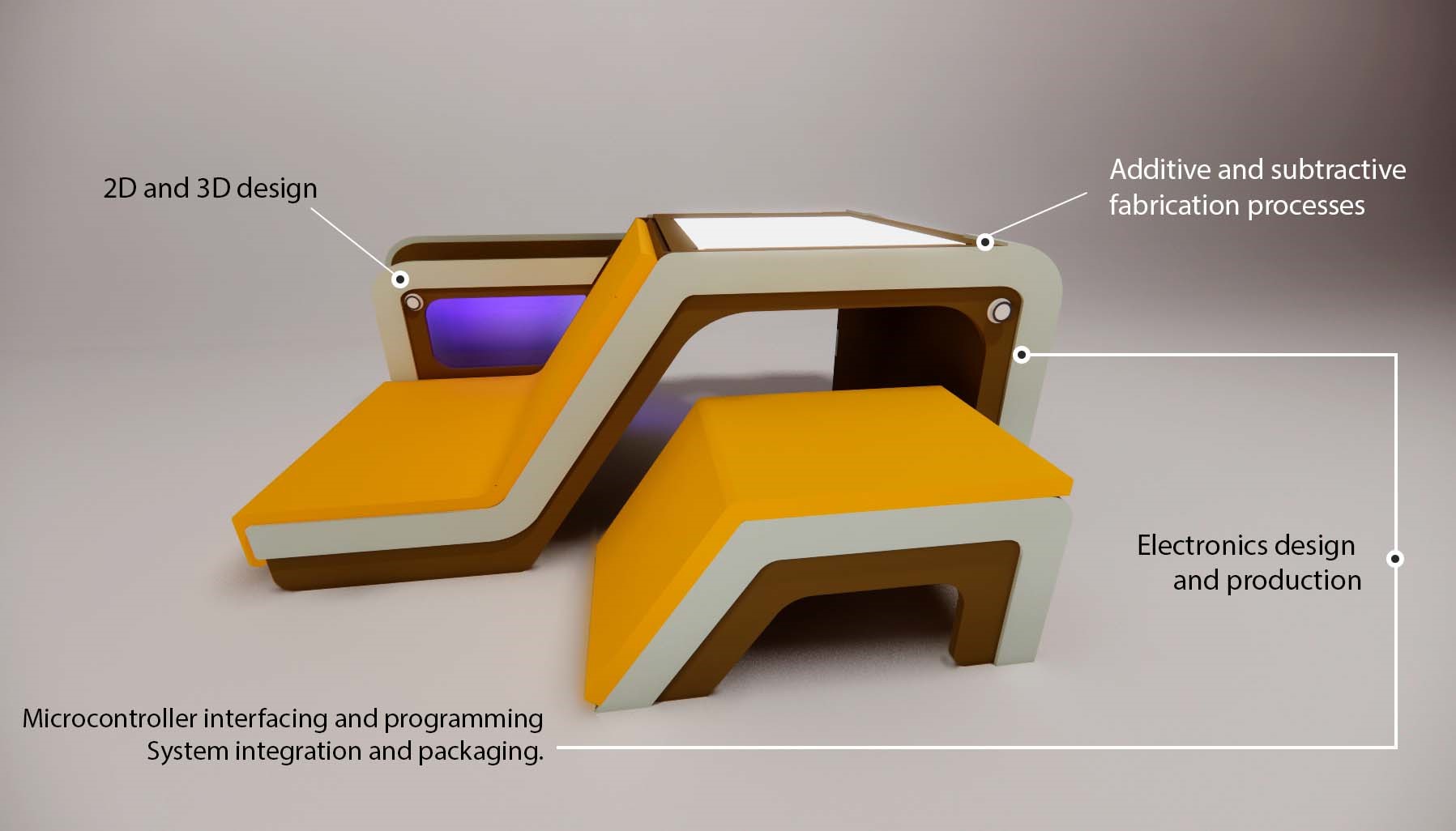
Name: Fab light table
Since my university days I have been interested in interior design and furniture concepts, in these working years I have designed architectural projects, interiors, packaging, and industrial design prototypes, added to this, due to my work in the Fab Lab, these last For 2 years I have focused on researching and applying STEAM and Montessori educational methodologies, since in the Laboratory we have the Fab Lab STEAM program where we bring knowledge of digital manufacturing and design to basic education students, from 8 to 16 years old. Last year we had the opportunity to teach more than 400 students.
This is a field with many possible areas of experimentation and research, from the development of sensory prototypes, to the design of outreach programs or the dignity of educational spaces. For my final Fab Academy project I will focus on creating a prototype with an innovative design that is functional and intuitive as well as easy to use, replicate, assemble, modify and improve. Inspired by Montessori teaching that promotes freedom and child autonomy.
Objective:
Design a multifunctional work table for children from 3 to 6 years old, which allows them to carry out the following activities:
1. Do homework
2. Draw
3. Create crafts.
4. Perform sensory experiments
5. Read
6. Save teaching materials
7. Interact with mobile devices.
The project seeks to integrate sensory experiments into a set of two pieces: an individual work table, a reading pillow, a light table and an auxiliary lighting system.
The design will incorporate:
• 2D and 3D design
• Additive and subtractive manufacturing processes
• Design and production of electronics.
• Interface and programming of microcontrollers
• System integration and packaging.
What will he do?
This furniture will include two SAMD11C14 microprocessor-controlled lighting systems.
o 1.- Table lighting system. The light table that is included in the design is projected as a pedagogical tool for multisensory experimentation.
This system is activated from a "button" which includes a capacitive sensor, so in a tactile way, the user can interact with the device from keystrokes.
The program stores the keystrokes in a variable and acts depending on the counter:
1 turns the system on, 2 to 4 creates white lighting intensity variations, 5 to 10 changes RGB colors, and 11 turns the system off. Presses of more than 8 seconds also turn off the system.
o 2.- Ambient lighting system. This system is projected as a sensory aid for creative activities in which it is required to change the perception of space based on color. This is an independent system from the one on the table, but it works in the same way, the user can interact from a capacitive sensor where, based on keystrokes, the device turns on the ambient lighting area and varies its color depending on the number of keystrokes.
o 1 turns on the system, 2 to 10 RGB colors change, and 11 turns off the system. Presses of more than 8 seconds also turn off the system
Both systems will be powered via USB with devices that operate at 5V
• Who has done what beforehand?
(I02) Version 1.0 design in week 3: Computer Aided design
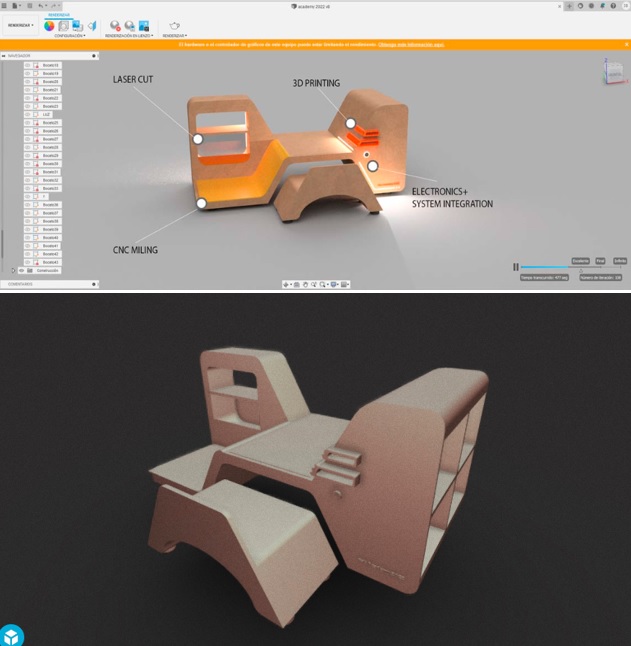
(I03) Design version 1.2
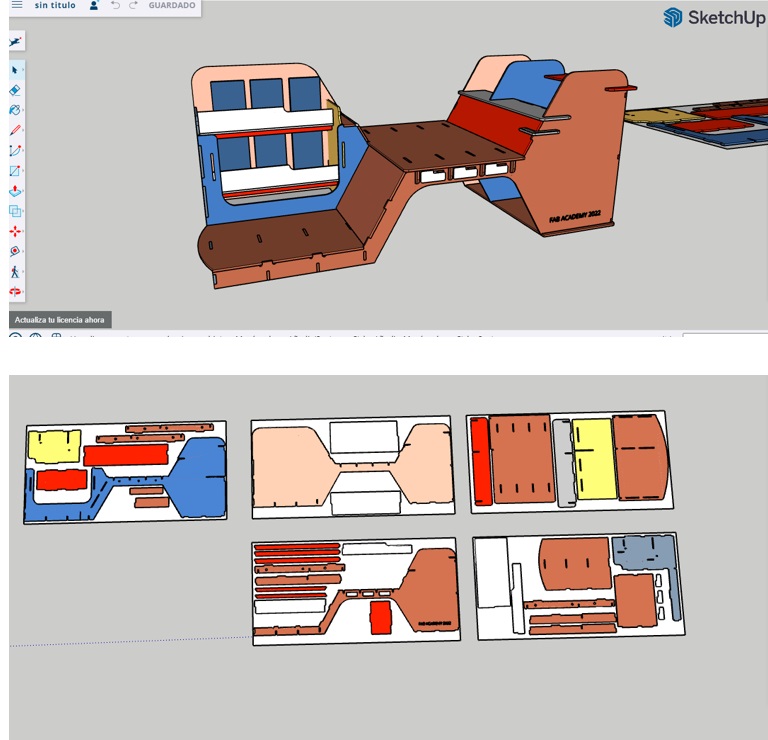
(I04) SWD programmer – D11C manufactured in electronic production week.
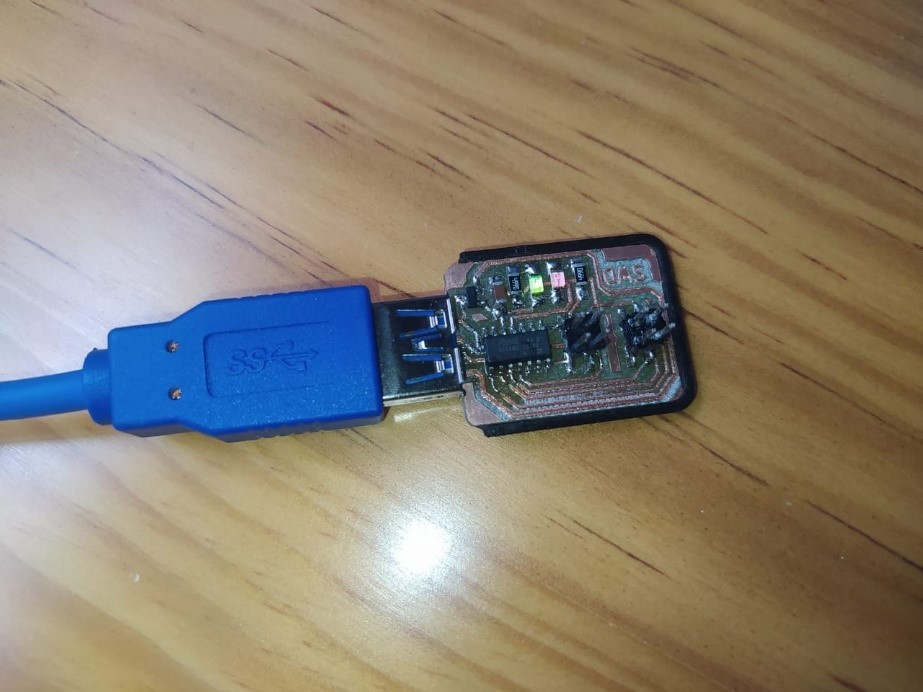
(I05) JOSAMD 1.0 development board based on SAMD11C14 manufactured in Device Week.
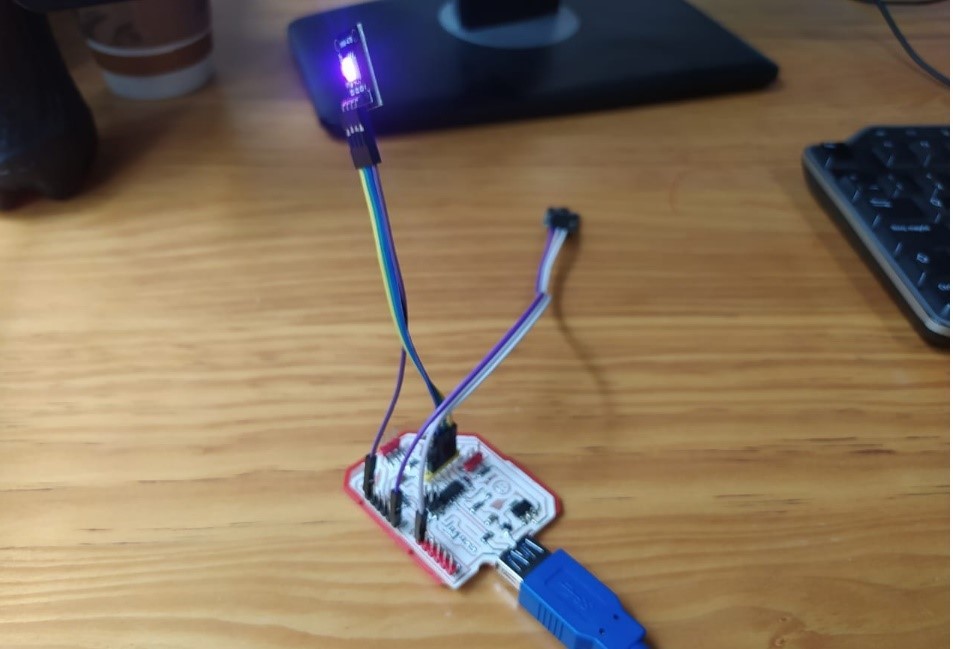
(I06) Communication board for I2C protocol, manufactured during Integrated Communications and Networking Week
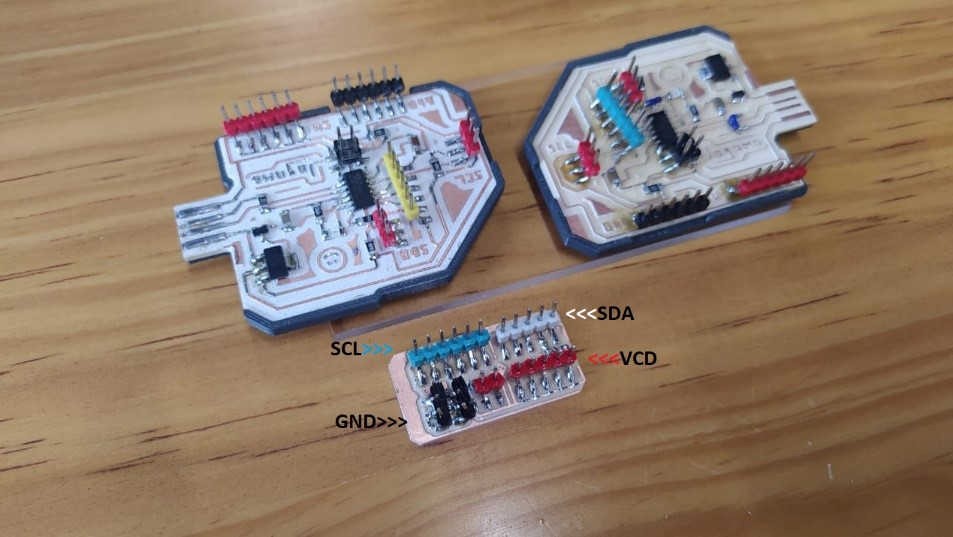
• What will you design?
I will redesign the furniture concept for the last time, at the time of writing this assignment the project already had versions 1.0 and 1.2, so based on the analysis of these previous versions I will redesign version 1.3 taking into account:
• Reduction of necessary materials
• Greater ease of assembly and transportation
• Reduce the total cost of manufacturing
• Greater pedagogical focus
I will design the structure, surfaces and accessories of the furniture in a CAD software, the main elements are:
or light table
o Reading area
o Storage shelves
or Bank
o Padded surface.
o Fastening elements
or Accessories.
o Buttons with capacitive sensors.
o Registration for the accommodation of the electronic components and maintenance of the device.
o Platform for both lighting systems.
In a CAD software for circuits I will design the electronics of the project:
o Main board based on a SAMD11C14 with USB port and 5V input.
o SAMD11C14 based daughter board with USB port and 5V input
o Board for I2C communication protocol.
In addition, these days I have taken the opportunity to see some trends in furniture design, both locally and internationally
Local:
https://kitmobiliario.com/?gclid=CjwKCAiA68ebBhB-EiwALVC-Nu4lifHPRg-TThXc2WShA7xtJipy8FnYzgqi7bKYrpByWiWRRqEb9hoCP3QQAvD_BwE
Light table:
https://www.etsy.com/mx/listing/709714459/mesa-de-luz-para-dibujo-de-arena
Handbook on teaching and learning through digital design and fabrication:
https://fablabproject.eu/wp-content/uploads/fablab-manual-es.pdf
• What materials and components will be used?
Where will they come from?
How much will they cost?
(I07)

• What parts and systems will be manufactured?
oLlight table
o Reading area
o Storage shelves
or Bank
o Padded surface.
o Fastening elements and accessories.
o Buttons with capacitive sensors.
o Registration for the accommodation of the electronic components and maintenance of the device.
o Platform for both lighting systems.
o Main, peripheral and I2C communication board (I08)
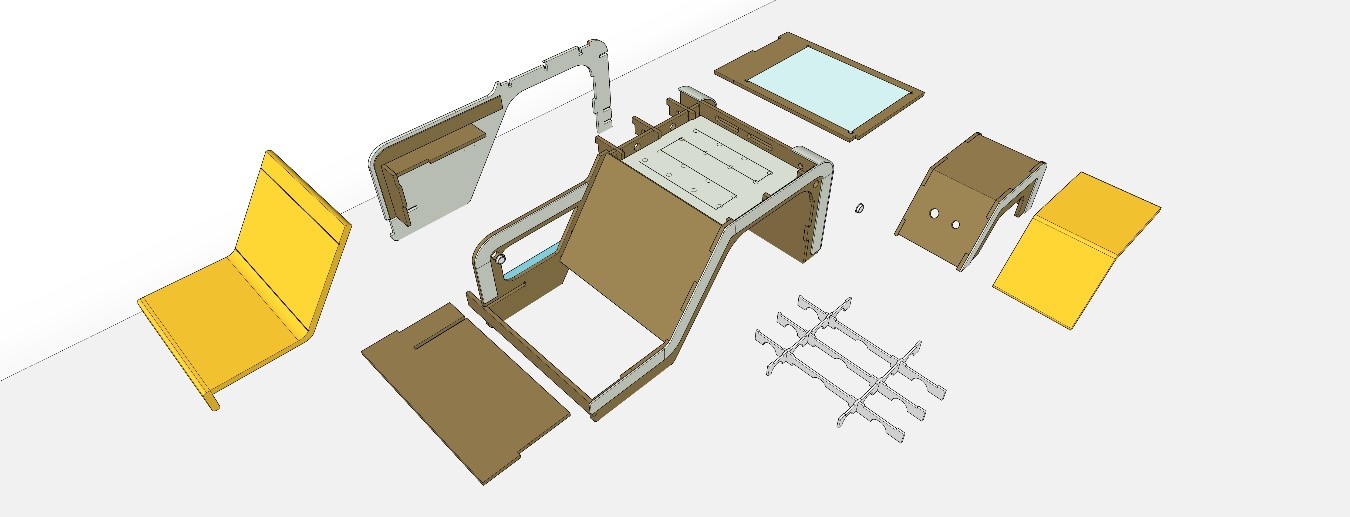
• What processes will be used?
o 3D printing: anchoring elements, accessories, buttons and bases for teaching material.
o CNC machining: Main structure and internal supports with 2D contour machining and 3D surface pocketing.
o Laser cutting: Covers, light table support and translucent cover.
o PCB milling: main board, peripheral and I2C communication
• What questions will be answered?
o Does the design have a wow effect on the target audience?
o Will the prototype meet the expected pedagogical expectations?
o Is it enough to power the entire system with a 5V power supply?
o Does centering the operation of the device in a single two buttons make an interface intuitive?
o What is the best strategy for the cable path?
o Is auxiliary lighting bright enough for multi-sensory activities?
• How will it be evaluated?
On the one hand, the project will be successful depending on the feedback from users and their parents, taking into account: the intuitiveness of the device, ease of use, comfort and usefulness in the activities for which it was designed.
On the other hand, the project will have reached the first level of success if I manage to make all the assemblies work and that the microprocessor executes the tasks that are planned from the flowchart.
![]()
![]()
![]()
Copyright 2022 Jose Manuel Diaz Bello